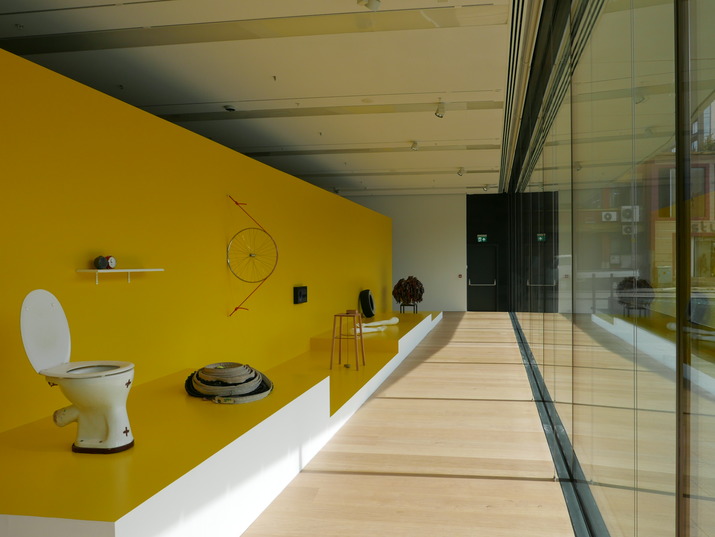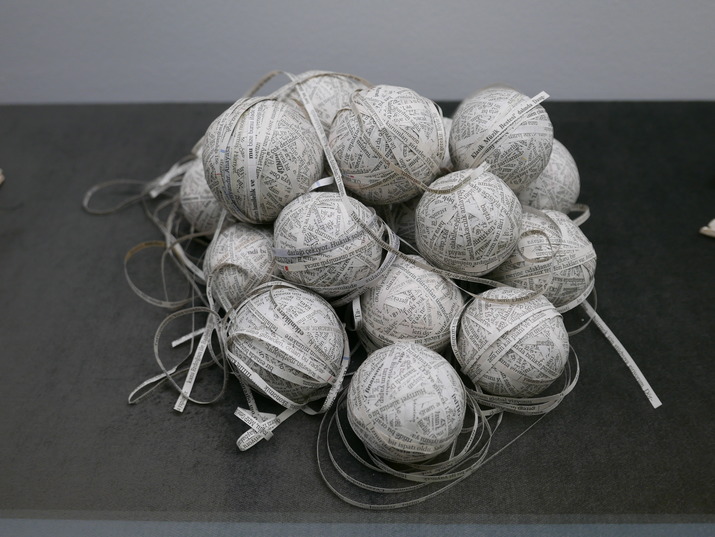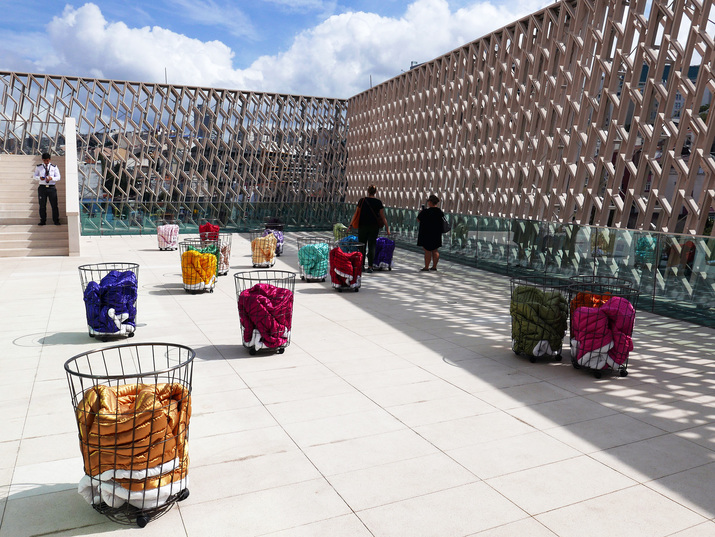
R
E
V N
E
X
T
From the time the Vehbi Koç Foundation (VKF) opened Arter – Space for Art, in May 2010, in a restored apartment building along Istanbul’s İstiklal Avenue, the site never felt sizable enough to accommodate all the artworks that the institution’s curators wanted to display. Arter’s inaugural exhibition, “Starter,” curated by René Block, was bursting with 160 works by 87 Turkish and European artists across five narrow floors, not to mention the inflatable tank by Michael Sailstorfer (T 72, 2007) that barely fit in the building’s largest, street-facing gallery. In the 34 subsequent shows over the next eight years, the modest-sized rooms and nooks of an early 20th century residence would be filled with works—and at every opening, the narrow spiral staircase would be perilously jammed with guests, wine glasses in hand. Slightly cramped viewing experiences quickly became part of Arter’s exhibition style, and in many cases it suited works by Turkish artists who often work in home studio spaces better than, say, Istanbul Modern’s sprawling warehouse layout.
Yet the original Arter building at 211 İstiklal Caddesi was always intended to be a testing ground for a larger institution. And finally at the end of the decade, in September 2019, Arter reopened in an 18,000-square-meter venue, with 4,000 square meters of gallery space across five floors in a purpose-designed building by Grimshaw Architects. In many surprising ways, the massive new Arter replicates the qualities of the original—a narrow, vertically oriented building of stacked floors with long, rectangular galleries, and smaller spaces with windows looking out onto the city, here quite directly onto the working-class areas on the hillside around Dolapdere. But now Arter has space for a library, education rooms, a conservation laboratory, an auditorium, a performance space, as well as an arts bookshop and café. Arter is, in short, a fully realized private museum, with a collection of more than 1,300 artworks, and has ambitious plans to maintain a busy exhibition program that will include many new commissions. Before that journey begins, here’s a look at the inaugural collection exhibitions at Arter, which showcased the artistic lineage of VKF’s holdings, and turned a spotlight on the multigenerational Turkish artists whose works now have a permanent home in Istanbul.
“Words Are Very Unnecessary”
Arter’s collection, and the institution’s approach to contemporary art at large, has been deeply influenced by German publisher, gallerist, and curator René Block, who, beginning in the mid-1960s, promoted the idea of artist-produced “multiples” (editioned objects), and had strong ties with the art of the everyday through Joseph Beuys and the Fluxus movement. Block has also had a long association with Turkey, curating the 4th Istanbul Biennial in 1995, the “Adventure İstiklal” exhibitions series (2007–10) at the Yapı Kredi Kâzım Taşkent Art Gallery for pioneering contemporary artists (the likes of Sarkis, Cengiz Çekil, Füsun Onur, Ayşe Erkmen, Hale Tenger), and he ran the VKF-funded art space Tanas in Berlin from 2008 to 2013, as well as serving as an advisor for VKF’s acquisitions.
The collection exhibition “Words Are Very Unnecessary,” curated by Selen Ansen, foregrounded Block’s performative, avant-garde slant toward postwar and contemporary art, with works by 42 artists. The first work one encountered was Fluxus member George Brecht’s Chair Events (1969), consisting of four chairs and objects (a can of paint, pair of shoes, loaf of bread, potted plant) that were meant to simultaneously suggest possibilities for performances. A street-facing display of objects includes Joseph Beuy’s sculpture of a toilet, Yeah Let’s Stop This Shit Now (1979), donated to the museum by Block, and Allan Kaprow’s tire, inscribed with “Yard,” which recalls his 1960s-era installations in which he filled spaces with hundreds of used tires. The show also featured many artists from Europe, such as Berlin-based Alicja Kwade, documentation of a Nevin Aladağ performance, costume-props by performance artist Rebecca Horn, Franz Erhard Walther’s rolled felt sculpture that can be enacted in various forms, a two-channel video by Sweden-based Meriç Algün, and a special showcase of artworks made from books by the comparatively young Istanbul performance artist Didem Erk. With so many pieces clustered together, “Words Are Very Unnecessary” made it clear that Arter’s house style of mounting shows had survived the transition to the new building.
“Words Are Very Unnecessary” is on view until May 10, 2020.
“What Time Is It?”
The Fluxus spirit was also present in the collection display in the upper-floor galleries. Presented by Arter’s chief curator Emre Baykal with Eda Berkmen, “What Time Is It?” featured 34 artists spanning filmmaker Jonas Mekas to Fluxus figures Nam June Paik and Reiner Ruthenbeck, and Sigmar Polke, as well as formative Turkish artists such as Füsun Onur, Nil Yalter, Bilge Friedlaender, and Sarkis.
The latter had a gallery of his own, presenting his seminal 1986 installation of objects from his family wrapped in the magnetic tape from cassettes, Çaylak Sokak, which was shown on a massive plinth that was the mirror-image of the floorplan of Maçka Sanat Gallery, where it was originally shown before being included in the famously controversial global exhibition “Magiciens de la Terre” (1989), organized by the Centre Pompidou’s Jean-Hubert Martin. Çaylak Sokak was supplemented by video works, whirling industrial black fans hanging from the ceiling, a sentence fragment on the wall (“carpets hung like thick curtains on the windows at night protected the lit-up house from the planes”), and a gilded architectural model of his family’s home, An Icon (2010), adding contemporary resonances of displacement and war plaguing the region.
The title of the group exhibition comes from a 2008 work by Cengiz Çekil (1945–2015) in which he silkscreened the Turkish phrase “SAAT KAÇ?” across spreads of newspapers; the many works in the show mark the passage of time and history. Cevdet Erek’s ruler sculptures mark day and night, and events in his father’s life, while Aslı Çavuşoğlu’s installation The Stones Talk (2013) features officially designated “insignificant” or “incomplete” artifacts from archeological digs. The show also featured three seminal installations from the 1990s: Am Haus (1994), Ayşe Erkmen’s still-extant text installation, on the exterior of a Berlin building in a once predominantly Turkish neighborhood, of the unique suffixes in the Turkish language used to indicate reported information; Hale Tenger’s barbed-wire fence and guard-hut installation made for the 4th Istanbul Biennial in 1995; and, on one of Arter’s rooftop patios, Gülsün Karamustafa’s installation Mystic Transport (1992), of wheeled baskets containing colorful blankets, referring to the dowry quilts that were traditionally carried by families migrating from villages to cities. Collectively the three works reflected on three major phenomena of Turkish postwar society: the mass migration of rural communities to northern, industrial Europe under guest-worker programs; a highly militarized society that endured coups d’état in 1960, 1971, and 1980; and the rapid urbanization of an agrarian population.
“What Time Is It?” is on view until March 22, 2020.
A second article looking at the three inaugural solo exhibitions by Turkish artists at Arter, has also been published.
HG Masters is the deputy editor and deputy publisher of ArtAsiaPacific.
To read more of ArtAsiaPacific’s articles, visit our Digital Library.














